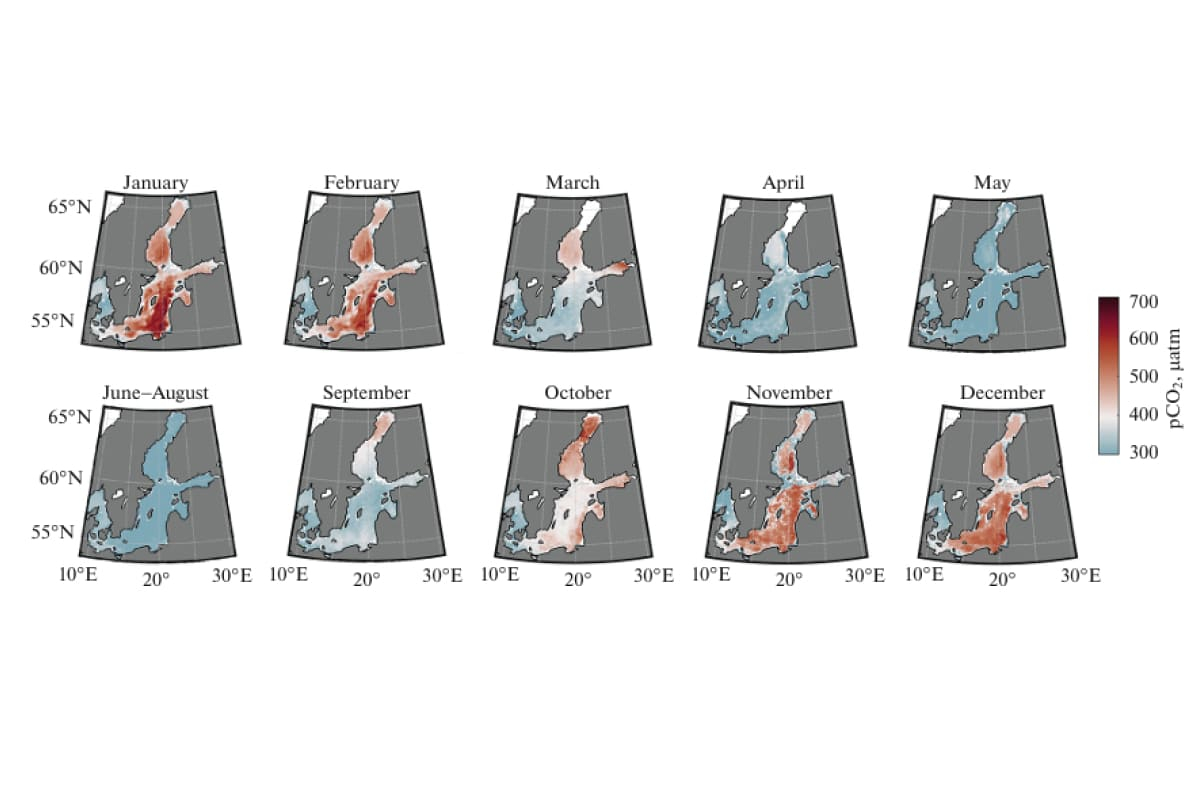Scientists from St Petersburg University develop neural network to assess carbon concentration in seas and oceans
Oceanographers from St Petersburg University have developed a neural network model that estimates the concentration of carbon dioxide in water based on parameters of natural composition. The algorithm has already been successfully tested using data from the Baltic Sea.

Marine plants absorb carbon dioxide dissolved in water during photosynthesis and, after dying, contribute to its long-term storage in the deep ocean. This natural process helps mitigate the greenhouse effect, as the World Ocean absorb approximately 25% of anthropogenic carbon dioxide emissions. However, excess carbon leads to acidification, which damages corals and shell-forming organisms. Additionally, the decomposition of organic matter reduces oxygen levels in bottom layer, resulting in the formation of ‘dead zones’.
The findings of the research conducted as part of the master’s thesis of a student in the programme ‘Physical Oceanography and Bioproductivity of Ocean and Seas (PHOBOS)’ are published in the scientific journal Oceanology.
The Baltic Sea, being shallow and enclosed, is particularly vulnerable to these processes. The abundance of river runoff and low water exchange with the Ocean lead to the rapid growth — or ‘blooms’ — of cyanobacteria, which increase carbon uptake but also degrade water quality and expand zones of oxygen depletion. This threatens the ecosystem and makes it increasingly vulnerable to further climate change.
To measure carbon dioxide in water, oceanographers use the partial pressure of carbon dioxide (pCO₂), which represents the pressure that the gas would exert if it alone occupied the entire volume. In oceanography, this parameter indicates the degree of CO₂ saturation in water compared to the atmosphere.
The specialists from St Petersburg University analysed environmental parameters affecting carbon dioxide concentration and developed a model to estimate partial pressure using artificial intelligence. For the neural network, they used indicators such as light, temperature, and salinity of the water body, as well as the depth of the mixed layer, drawing data from the open SOCAT expedition database and satellite observations.
‘We have created hCO2 maps for the surface layer of the entire Baltic Sea using real measurements of water parameters. These maps make it possible to estimate this parameter more accurately in areas where measurements are infrequent — for example, near coastal bays or during autumn and winter. Our model provides realistic results, confirmed by satellite and modeled data,’ said Polina Lobanova, Associate Professor at the Department of Oceanology, St Petersburg University, and Lecturer at the Russian Society ‘Znanie’.
Polina Lobanova, Associate Professor at St Petersburg University, was among the winners of the All-Russian competition ‘Znanie. Lecturer’ and received a special prize—a river cruise with the opportunity to deliver lectures on board. She also spoke about her work as an ocean scientist and the World Ocean in St Petersburg University’s Heinrich Terahertz podcast.
According to Sofia Kuzmina, a graduate of St Petersburg University, machine learning operates with two types of data: training and test data. The former is used to teach the model which values of pCO₂ correspond to specific parameters. For example, as water temperature decreases, the partial pressure may increase due to the higher solubility of the gas. The algorithm memorises this relationship and analyses it in combination with other factors to make effective use of the information later.
The model was subsequently validated on a test dataset, where it independently predicted partial pressure values based on new input parameters. The researchers compared the model’s predictions with actual expedition data from the Baltic Sea and confirmed the system’s accuracy.
Sofia Kuzmina, a graduate of St Petersburg University, is a two-time winner of the Petropolitan Science (Re)Search Open International Olympiad of St Petersburg University for students and young professionals in Earth sciences. She has participated in scientific expeditions focused on environmental monitoring in Avacha Bay (the Bering Sea), Penzhina Bay (the Sea of Okhotsk), and other university-led research projects.
‘We use a multilayer perceptron — a type of neural network that predicts pCO₂ using several hidden decision layers. At each stage, the contribution of different parameters is taken into account, which helps to avoid the over-training typically associated with such models and enables us to obtain an unbiased estimate,’ added Sofia Kuzmina.
The study also examines multi-year and seasonal variations in pCO₂ in the Baltic Sea. These results are consistent with previous research, further confirming the accuracy of the model.
St Petersburg University, the oldest university in Russia, was founded on 28 January (8 February) 1724. This is the day when Peter the Great issued a decree establishing the University and the Russian Academy of Sciences. St Petersburg University today is a major centre for education and research. More than 20,000 students study here, and more than 15 major laboratories and 23 resource centres have been established as part of the country’s leading Research Park. Graduates of the University have been recipients of the Nobel and Fields Prizes on multiple occasions. Recently, St Petersburg, the Northern Capital of Russia, officially introduced a new holiday—Day of St Petersburg University—which has been included in the St Petersburg Law ‘On holidays and commemorative days in St Petersburg’. In February 2025, a ceremonial event was held, during which Roscosmos cosmonauts presented the University with the ‘300th anniversary of St Petersburg University’ flag, which had travelled to the International Space Station and back.

